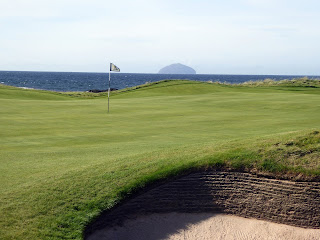White tees par 71, SSS 72, 6597 yards
Red tees par 72, SSS 73, 5696 yards

Golf is first recorded in Dunbar in 1616 when golfers were reprimanded by the Church for playing on the Sabbath (Sunday). This was probably on the West Barns Links which was the course where the Dunbar Golfing Society was inaugurated in 1794. The Dunbar Golf Club was formed in 1856 prompted by the opening of a railway in 1846 and the establishment of a military barracks in 1855. After 'clearing of the ground' (which suggests that there was no pre-existing course) the East Links was formed as a fifteen hole course which lay to the seaward of the wall which runs between the current 4th and 18th holes. An eighteen hole course was set out in 1880 with four further alterations being done over the years by such illustrious names as Old Tom Morris, James Braid and Ben Sayers. The course was extended to its current length in 2008.
 |
| 'Jackson's Pennies', the well bunkered 3rd green with the old deer wall in the background |
Dunbar is a typical classic links course which runs more or less straight out and straight back. All but four of the holes (1st, 2nd, 3rd and 18th) lie on the seaward side of an old red sandstone deer park wall between it and the rocky coastline. We played the course with Norma Richmond in a team event on a windy day. It starts with two fairly ordinary par 5s on the landward side of the wall followed by a tricky and punishingly bunkered par 3 named 'Jackson's Pennies' after a former member who used to spend all day betting pennies on whether players would hit the green. The path from the 3rd to the
4th goes through the old wall and the player is greeted by magnificent views of the Forth estuary and its islands which can be seen from every hole and this is where the true links nature of the course starts. Hugging the coastline the 4th is a lovely par 4 which on first sight looks easy but beware the fast and undulating green. After a testing par 3 the 6th and 7th follow the old deer wall which punishes a slice with an out of bounds penalty. The 7th is even more testing as it is a dog leg to the right over the crest of a hill to a downhill green between the wall and an old boathouse. The 9th hole will also punish a slice with a blind drive and the wall on the right.
 |
Looking back to the town of Dunbar from the 4th green
with the Bass Rock in the distance
|
At the 11th the course turns for home and there is a run of three excellent par 4s from the 12th to the 14th. The 12th stands out as a testing hole which doglegs slightly left to right to an infinity green with water awaiting an errant shot to the right. The 14th heads back towards the old boat house and is framed by a lovely view of the Bass Rock. The homeward run of holes are just as much fun with a tricky par 3 at the 16th and the 17th green close to the wall. The 18th is back on the landward side of the wall but again a slice will flirt with out of bounds. Dunbar is not a happy course for the chronic slicer!
This is a difficult course for ladies with only one par 4 being less than 300 yards but it is a links course of quality with tight lines, fast running fairways and true greens. It stands out for its views of the sea which are lacking in many links courses.
 |
| Looking back up the 12th hole - there is trouble on the right! |
Worth playing? Yes














































